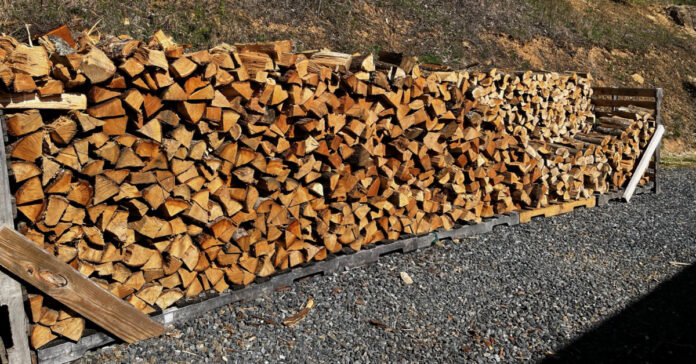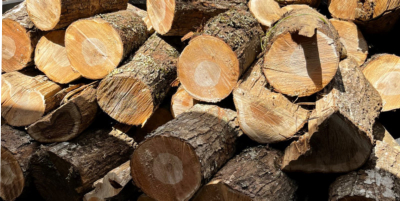
This weekend, I reminded myself why I buy wood that is already cut and split, even if requires some re-splitting. Let me explain.
My daughter’s family came to visit this weekend. Her husband, who is 20-some years younger than I, usually helps me out with some of the more strenuous tasks around the homestead. Knowing he was coming, I ordered a cord of wood and we split and stacked it on Saturday.
It went well and we enjoyed ourselves. I mean, let’s be honest, we have a hydraulic splitter and a cord isn’t that much wood. I would guess than about 40 percent of the pieces needed to be split, so we would grab up the smaller splits and add them to the woodpile. Those bigger, chunkier pieces would get tossed onto a secondary pile, and when we it grew large enough, one of us would split the wood while the other one would take the resulting pieces and walk them over to the pile.
We took turns working the splitters, so neither of us ended up with a sore back. You see, the splitter is just the wrong height and using it forces me to hunch over, resulting in some back pain if I run the splitter too long. By breaking it up with stacking and walking around, my back didn’t get sore and wasn’t even stiff the next day.
When we finished, we felt good. We did some minor chores but saved the big one, cutting up the firewood poles I had been given, until the next day.
Chain Sawing
On Sunday, we came out at noon to tackle the logs, most of which were 10 to 12 feet long. We set up the sawhorse and my son-in-law grabbed one of the smaller logs and placed it on the sawhorse. We then developed a process by which we could work efficiently. He held a thin piece of wood on which I had marked one-foot increments and I used the chainsaw to make a quick cut so I would know where to cut the logs. He’d move the stick, I’d make four more notches, and then I’d cut rounds off the log, moving from one end of the sawhorse to the other when necessary to keep one side from getting too heavy and unbalancing the saw horse.
Note that the large wood stove in the basement fits logs up to 26 inches long. Our fireplace insert upstairs has a much smaller firebox and while you can squeeze a 16-inch log in, smaller chunks are better. That’s why we cut these to one-foot lengths.
We got off to a good start. Because I had tested the saw a few weeks ago when I started all my gas-powered equipment, the Stihl started right up. I had sharpened the chain, so the saw cut well, making large chips of sawdust. I was cutting through the wood with ease. We chopped up four logs and then stopped to toss all the wood into the back of the pickup truck. We still had more room in the truck, so we cut another two logs.
Changing Plans
Our plan was to drive up hill to the splitter, toss out the logs, and then return to sawing. We decided, however, to split them right off the back of the truck. That would save handling the wood a second time and would avoid the need to bend down and pick up a round. What we didn’t count on is that splitting a log into four or six pieces takes two to three times longer than splitting a large split into two pieces. So it took longer than expected to split a truckload of wood.
When we were finally done, we took a brief break, hydrated, and headed back down the hill to the logs. We still felt pretty good.

We had initially picked out the low-hanging fruit, meaning the smaller pieces. Now we were facing lengths of wood that were too heavy for us to lift. We cut them into four-foot lengths and then he walked them end-over-end to the sawhorse where he lifted them into place. It was like watching a cross-fit exercise.
With bigger logs, it took fewer pieces to fill up the back of the truck, but the took longer to cut. Splitting the logs also took longer because they were bigger in diameter and needed to be split into more pieces. When we called it a day and went in to shower off the sawdust and eat dinner, we were worn out. We had burned through two tanks of gas in the saw and were working in our second on the splitter.
We also had the biggest logs left uncut.
Tackling the Big Logs
Unfortunately, they left the next day. I took two ibuprofen and did nothing more strenuous than throw a couple trash bags into the back of the truck and take them to the dump. I was stiff. By the end of the day, I was a little sore, but it was a good kind of sore, not the painful “I need to go to the chiropractor” kind of soreness.
But now I have five or six logs that are 12 inches or more in diameter that need to be cut and split, and they are not going onto the sawhorse! I plan to tow the splitter to the fire wood, convert it from horizontal to vertical mode so I don’t have to lift the rounds, and split it right there. I’d rather toss splits into the back of the truck than lift and toss 12 or 14-inch rounds. These logs will produce a nice pile of firewood. In fact, I can say that it looks like a lot more wood after you have cut and split it.
Once I fill in the small gap you see in the main photo above, it will have two rows of stove-ready splits 20 feet long. Considering it is stacked at least 4-1/2 feet high, that gives me almost two full cords. I have another pile equally as big I worked on earlier this winter, and I have almost a full cord that we didn’t burn this year because it was a warm winter. That gives me about 4.5 cords. I expect I will buy at least one more load, since I like to go into the winter with at least five or six cords of seasoned firewood.
Lesson learned
I was surprised to learn that the actual sawing of the logs is the easiest part of the process, thanks to having a chainsaw. Tossing and/or lugging the wood is more strenuous. Because of the awkward height of the splitter, splitting logs when it is in the horizontal configuration is sub-optimal. I’ve only used it vertically once, so we’ll see how that goes.
When we first moved here, I had considered buying a side-by-side to use to log trees on our 20 acres and carry logs out of the forest. I decided not to because they were so expensive, I could buy ten years of firewood for the same price. This weekend demonstrated I had made the right call. If I was cutting all my firewood, I would probably want to upgrade the splitter and possibly get a larger saw. So by buying firewood, I am saving even more money than I thought.
This weekend proved I can still cut and split firewood and will do so if necessary. Thankfully, it isn’t necessary and I have almost a full year’s supply of wood on hand.






